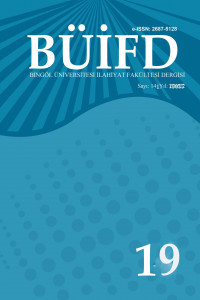Hassân bin Sâbit'in Şiirinde Şam ve Hicaz Arasındaki Estetik Değer Kaymaları
Hassân bin Sabit, Şam, Hicaz, Temeddün, Estetik değerler
Transformations of Aesthetic Values Between Levant and Hejaz in the Poetry of Hassan bin
Hassan bin Sabit, Levant, Hejaz, Urbanism, Aesthetic values,
___
- Abdülhamîd, Şâkir. Et-Tefdîlü'l-Cemâlî. Kuveyt: Âlemü'l-Marife, 2001.
- İbn Sînâ, Ebû Alî. En-Necât. Kahire: Matbaatü Mısır, 1331.
- İbn Manzûr, Ebu'l-Fazl. Lisânü'l-Arab. Beyrut: Dâru Sâdır, 3. Basım, 1414.
- el-Askerî, Ebû Hilâl. el-Furûku'l-Luğaviyye. thk. Muhammed Selîm. Kahire: Dâru'l-İlm ve's-Sakafa, ts.
- ed-Dımeşkî, İbn Asâkir. Tarîhü Dımeşk. Dımeşk: Dâru’l-Fikr, 1995.
- el-Endülüsi, İbn Hazm. Camharatü ensabi'l-Arab. thk. Abdusselâm Hârûn. Kahire: Dâru’l-Maarifi'l-Mısriyye, 5. Basım, ts.
- el-Feyrûz, Abâdî. el-Kâmûsu'l-Muhît. Beyrut: Muessetü'r-Risâle, 8. Basım, 2005.
- el-Hazrecî, Hassân bin Sâbit. Dîvân. Kahire: Matbaatü's-Saâde, 1331.
- el-Hamevî, Yâkût. Mucemü'l-Büldân. Beyrut: Dâru Sâdır, 2. Basım, 1995.
- el-İsfahânî, Ebu'l-Farac. el-Eğânî. Beyrut: Dâru'l-Fikr, 2. Basım, ts.
- Souriau, Étienne. el-Cemâliyyetü abre'l-usûr. çev. Mişel Âsî. Beyrut: Menşûrât Uveydât, 2. Basım, 1982.
- el-Kurtubî, Ebu'l-Hasan. et-Tarîf Bi'l-Ensâb. Kahire: Dâru'l-Menâr, 1990.
- Başlangıç: 2013
- Yayıncı: ÖMER TAY Dr.
Kur'an Bağlamında Sabır ve Şükür İlişkisi
Sosyal Çatışma ve Din: Matürîdî Düşüncede İzdüşümleri Üzerine Bir İnceleme
Mezhep İçi Eleştiri Kültürü: Ebû İshâk Eş-Şîrâzî’nin Ebû Sevr Eleştirisi
Aynü'l-Kudât-ı Hemedânî'ye Göre Kur'ân'ın Hakîkati ve Temel Mânevi Özellikleri
Risâletine Delil Oluşu İtibariyle Kur'an'da Hz. Muhammed'in Nübüvvet Öncesi Hayatına Dair İzdüşümler
Eyyûbîler Döneminde Mısır'da Sünniliğin Yerleşmesinde İranlı Âlimlerin Rolü (ÇEVİRİ)
Bedrettin BASUĞUY, Çevirmen: Bedrettin BASUĞUY
Müstakîm-zâde'nin Sözlükçülüğü ve Tercüme-i Kânûnu'l-edeb Adlı Tercümesi
Mehmet ÖZTÜRK, Abdullah Muaz GÜVEN, Ahmet YILMAZ
Latin Alfabesinin Kabulünden Sonra Kur’an Elifbası Öğretiminin Dönüşümü (1928-1972)
İdeoloji ve Medya: Batı ve Ortadoğu Medyasında Ayasofya Haberlerinin Söylem Analizi
